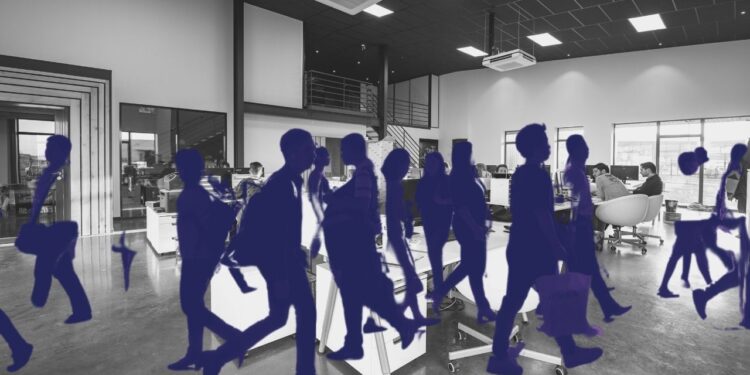- The average occupancy of offices in 10 major U.S. cities is 38% – compared to the 54% of offices in the Austin metro area that are occupied.
- New data from The Partnership for New York shows that just 8% of Manhattan office workers have returned to the workplace full-time.
- Bisnow predicts that things are likely to level out at a 55%-65% return rate – but only on some days.
New data from The Partnership for New York shows that just 8% of Manhattan office workers have returned to the workplace full-time.
Manhattan’s thousands of offices are largely empty, and it looks like they will remain so for a while. Remote work in New York City won’t end post-pandemic; 78% of businesses plan to keep hybrid arrangements.
The exodus from office buildings and rise of remote work has prompted concern from some city officials, namely NYC Mayor Eric Adams.
Adams has argued that fully reopening offices is vital for the city’s recovery because it will help low-income New Yorkers – whose livelihoods are tied to those workplaces.
This is a stark contrast to Texas and its return to office plans – which are rebounding quickly.
It seems that almost nowhere has been more successful in bringing employees back to the office than Texas, where major cities in the Texas Triangle — Austin, Dallas and Houston — lead the nation in office returnees.
The average occupancy of offices in 10 major U.S. cities is 38% – compared to the 54% of offices in the Austin metro area that are occupied.
A multitude of factors are contributing to Austin’s ability to bring employees back to the office.
Austin has seen massive growth over the past 10 or so years, especially among young professionals who work in finance and corporate offices for tech companies like Amazon, Meta and Apple – all of which opened offices or expanded their operations in Austin over the last two years. These jobs are more likely to require employees to return to the office.
Here are the five American cities with the highest office occupancy rates, according to Kastle’s data:
1. Austin – 58.8%
2. Houston – 50.9%
3. Dallas – 49%
4. Los Angeles – 39.8%
5. Chicago – 37%
Here are the five American cities with the lowest office occupancy rates, according to Kastle’s data:
6. San Jose – 31%
7. New York City – 32.9%
8. San Francisco – 33.4%
9. Philadelphia – 35.3%
10. Washington D.C. – 36.6%
What can we expect in the coming months in terms of office occupancy?
Bisnow predicts that things are likely to level out at a 55%-65% return rate, but only on some days.
Many companies are requiring employees to come back to the office for just a few days a week.
Dell, which reopened on March 7 for voluntary return, said it emphasizes an “outcomes-based workplace model” and that employees can continue to work remotely or in the office.
Apple directed workers to return to its campuses and other offices at least once a week, starting April 11. On May 23, it will start increasing the requirement to three days per week.
IBM offices reopened March 1, also on a voluntary basis, for fully vaccinated employees but hasn’t announced plans beyond that.
Facebook parent company Meta has said it will continue to have a flexible, hybrid approach to workers’ return, including a program that allows extension of remote work for those who don’t feel ready to go back to the office.
The future of the office is increasingly hybrid, but will continue to most likely change with the needs of workers.
Does the commute have anything to do with cities’ return to office efforts?
Perhaps the commute on public transportation is less desirable than a private commute in a car.
Metrobus has hovered around 70% of pre-pandemic ridership for months, but Metrorail, whose customers generally have more opportunities to work remotely and drive, lagged at about 30% in March.
Meanwhile, motorists are reporting significantly more rush-hour traffic in recent months particularly after more offices reopened March 1.
Morning traffic volumes on some arteries headed into downtown Washington D.C. grew, on average, by almost 9% between late February and early March, according to the District Department of Transportation.
Regional transportation planners say they are hearing that some carpools and van pools (most common among auto-dependent commuters from farther-out suburbs) haven’t reformed as trips to the office have become less regular.
It seems that when workers do actually have to come into the office, they prefer to drive… although many would rather not commute at all.
Changes in how Americans work could have long-lasting implications on tax revenues in cities with significant numbers of commuters, according to the Pew Research Center.
Now that many of the remote and hybrid policies that U.S. employers adopted out of necessity in 2020 are becoming permanent, some employees will be able to cut back or eliminate the time they spend commuting or move farther from their place of work.
Fewer commuters, or workers who commute less often, will translate into a shrinking local revenue base and contribute to fiscal challenges for office buildings, and more broadly, local governments.


 Dr. Gleb Tsipursky – The Office Whisperer
Dr. Gleb Tsipursky – The Office Whisperer Nirit Cohen – WorkFutures
Nirit Cohen – WorkFutures Angela Howard – Culture Expert
Angela Howard – Culture Expert Drew Jones – Design & Innovation
Drew Jones – Design & Innovation Jonathan Price – CRE & Flex Expert
Jonathan Price – CRE & Flex Expert













